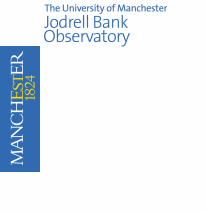Technical Projects 2003
Pulsars provide the nearest thing to a physicist's dream come true. Being the end-point of stellar evolution, they are densest bodies next to black holes and give us an insight into the most extreme physical conditions of matter density, pressure and magnetic field observable by man. They also provide the most precise clocks known to humankind for undertaking unique experiments of gravitation and general relativity. Furthermore, they can be used as probes of the distribution of ionised material and magnetic field in the Galaxy with a precision which nothing else can. We use the telescopes at Jodrell Bank, Parkes (Australia) and Arecibo (Puerto Rico) in this work and frequently travel to the foreign instruments to make observations. The pulsar group at Jodrell Bank are arguably the most productive in the world in this area and have discovered more than three-quarters of the known population of these elusive and fascinating objects.
There are four technical projects related to pulsar astronomy. We outline each of them below. For more information contact anyone from the pulsar group or those named above.
COBRA - A Graphical User Interface to Monitor
Pulsar Observations
COBRA (Coherent On-line Baseband Receiver for Astronomy) is a high performance computer cluster which allows the traditional signal processing of existing radio radio astronomy data acquisition systems to be performed entirely in software. This state-of-the art "digital receiver" is about to begin regular monitoring observations of pulsars when the Lovell telescope comes on-line again in the autumn. While most of the necessary development to obtain pulse profiles has been done, much work is required to develop tools to monitor the data quality and system performance.
We are currently working on a graphical interface monitor to COBRA using the Tcl/Tk and PGPLOT software packages as the display environment. This project is in its early stages (see screen dump below) and would benifit substantially from the input of a pair of students to help with the software development of this system. Some knowledge of the C programming language would be useful, though most of the source code will be written using the Tcl scripting language which has a relatively simple syntax and is easy to learn. As well as being a good opportunity to get hands-on experience with real radio astronomy data, this project would be an excellent introduction to graphical user interfaces and real-time programming.
COBRA - Testing The Precision of The New Pulsar
Supercomputer-Backend
COBRA (Coherent On-line Baseband Receiver for Astronomy) is a high performance computer cluster which allows the traditional signal processing of existing radio radio astronomy data acquisition systems to be performed entirely in software. This state-of-the art "digital receiver" is about to begin regular monitoring observations of pulsars when the Lovell telescope comes on-line again in the autumn. While most of the necessary development to obtain pulse profiles has been done, we are interested to know whether COBRA can fulfill its promises.
COBRA should provide timing accuracies better than obtainable with most other telescopes in this world. In this project the student would help in obtaining pulsar data with the Lovell telescope and would measure the precision of the resulting timing information. A comparison to data obtained with the exisiting backend in parallel would demonstrate the superiority of COBRA.
Next Generation Telescope - Designing the Future
An international community of scientists and engineers is currently working towards the realization of the most powerful radio telescope ever built on Earth, the Square Kilometre Array (SKA). Their common vision is to construct a flexible instrument that will become the world's premier imaging instrument. The SKA will:
- have a collecting area 30 to 100 times larger than for any radio telescope ever built;
- have a continuum sensitivity of a few tens of nano-Jansky;
- have a spatial resolution better than the NGST and ALMA;
- have a field-of-view larger than the full moon;
- have multiple beams, allowing different astronomers to do their science simultaneously;
- allow profound advances in all areas of astronomy.
PSRINFO - A Database for Pulsar Astronomy
The Parkes Multibeam Survey has increased the number of known pulsars to over 1500. With so many pulsars, it is increasingly important to have a user-friendly, comprehensive and easily-updatable database of pulsars and their measured and derived parameters. Many pulsar astronomers currently use the program `psrinfo' to interact with a database containing information on a number of pulsars. This program is in need of being updated, and possibly substantially rewritten, so that it is easier to use, compile, and call from programs. Additional parameters for pulsars need to be added and updated as well. The program is written in C but has some Fortran subroutines. Knowledge of the C programming language is a necessity; some experience with Fortran is desirable. Students taking up this project would be doing a great service to the pulsar community at large. This project would also be an excellent introduction to pulsars and the many physical parameters one can glean from observing them. It would also be very useful as an introduction to dealing with large datasets, an increasingly common problem in all areas of astronomy.
